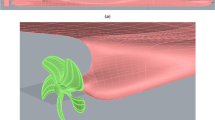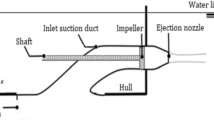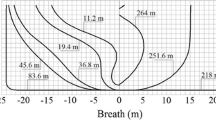Abstract
We studied the scale effect of the thrust deduction factor on an innovative self-propulsion procedure. In contrast to the International Towing Tank Conference (ITTC) committee documents, which adopt a skin friction corrector and also state that the thrust deduction factor is the same for both the model and full scales, complex interaction remains unresolved. Since the skin friction corrector is always calculated by an equation, to date no verifications of this equation have been published. In addition, the scale effect of the thrust deduction factor has seldom been studied because it is minor compared to that of the wake fraction. In the first section of this paper, the existence of the scale effect on the thrust deduction factor is proven and the misinterpretation of the equality is highlighted. Second, a balanced self-propulsion procedure, which does not use the skin friction corrector to isolate the propeller loading effect is proposed and compared to the conventional standard ITTC procedure. The study derived a simplified model for predicting the full-scale values for the thrust deduction factor correction. The new procedure was applied to a moderate-speed containership by CFD software and several characteristics were demonstrated. The scale correction model was verified from the computational results.


























Similar content being viewed by others
Abbreviations
- \(\otimes\) :
-
Midship symbol
- AP:
-
Aft perpendicular
- FP:
-
Fore perpendicular
- SA:
-
Sectional area (m2)
- GL:
-
Girth length of a section (m)
- Re :
-
Reynold’s number
- Superscripts :
-
Full-scale value
- Superscriptm :
-
Model-scale value
- R T :
-
Hull resistance when towed (N)
- R :
-
Hull resistance when propelled (N)
- R w :
-
Wave-making resistance (N)
- R aug :
-
Augmented resistance (N)
- ΔC F :
-
Roughness allowance
- K :
-
Form factor
- w n :
-
Nominal wake fraction
- J :
-
Advance coefficient
- K T :
-
Thrust coefficient
- K Q :
-
Torque coefficient in open water
- K Qb :
-
Torque coefficient behind hull
- n :
-
Rotational speed (rev/s)
- SFC:
-
Skin friction corrector, also denoted R A (N)
- F D :
-
Carriage dynamometer force (N)
- w e :
-
Effective wake fraction from thrust identity method
- t :
-
Thrust deduction factor
- \(\delta\) :
-
Scale-effect multiplier of thrust deduction factor
- \(\eta_{\text{H}}\) :
-
Hull efficiency
- \(\eta_{\text{R}}\) :
-
Relative rotative efficiency
- \(\eta_{\text{O}}\) :
-
Open-water propeller efficiency
References
ITTC (2002) Report of Resistance Committee, p.64, 23rd International Towing Tank Conference, Venice
ITTC (2002) Recommended Procedure. 1978 Performance Prediction Method, Procedure Number 7.5-02-03-01.4
NPL (1965) BTTP 1965 standard procedure for the prediction of Ship performance from model experiments, NPL Ship TM 82
ITTC (2008) Report of the specialist committee on wake fields. In: Proceedings of 25th ITTC, vol. II, Fukuoka
Bugalski T, Hoffmann P (2011) Numerical simulation of the self-propulsion model tests, Second International Symposium on Marine Propulsors, smp’11
Tahara Yusuke, Wilson Robert V, Carrica Pablo M, Stern Frederick (2006) RANS simulation of a container ship using a single-phase level-set method with overset grids and the prognosis for extension to a self-propulsion simulator. J Mar Sci Technol 11:209–228
Molland AF, Turnock SR, Hudson DA (2011) Ship resistance and propulsion: practical estimation of ship propulsive power, 1st edn. Cambridge University Press, New York
Hughes G (1954) Friction and form resistance in turbulent flow and a proposed formulation for use in model and ship correlation. Trans R Instit Naval Archit 96:314–376
Dawson C W (1977) A practical computer method for solving ship-wave problems. In: Proceedings of the 2nd International Conference on Numerical Ship Hydrodynamics, pp 30–38
Raven HC, van der Ploeg A, Starke AR, Eça L (2008) Towards a CFD-based prediction of ship performance—progress in predicting full-scale resistance and scale effects. Proceedings of RINA-CFD-2008, London, UK
Kim Y (1992) Thrust deduction prediction for high speed combatant ship, David Taylor Research Center, Bethesda, Maryland 20084-5000
Schlichting Herrmann, Gersten Klaus (2000) Boundary layer theory, 8th edn. Springer, Berlin
Fox RW, McDonald AT, Pritchard PJ (2003) Introduction to fluid mechanics, 6th edn. Wiley, Hoboken, New Jersey, pp 331–333
Stern F, Wilson RV, Coleman HW, Paterson EG (1999) Verification and validation of CFD simulations, IIHR Report No. 407
Kume K, Ukon Y, Fujisawa J, Hori T, Tsukada T, Haruya T (2000) Uncertainty analysis for the KCS model tests in the SRI 400 m towing tank, Ship Performance Division Report, No. 00-008-1
Fujisawa J, Ukon Y, Kume K, Haruya T (2000) Local Velocity Field Measurements around the KCS Model in the SRI 400 m towing tank, Ship Performance Division Report, No. 00-003-2
García-Gómez A (2000) On the form factor scale effect. Ocean Eng 27(1):97–109
Acknowledgments
The authors wish to thank Professor Jing-Fa Tsai and Professor Jeng-Lih Hwang for the technical discussions. We also thank Chi-Chaun Chen, Bo-Yen Chen and Yun-Shan Wang for their great contributions to the experimental and computational references. In addition, the authors wish to thank Bryan Nelson for English proofreading and grammatical revision supports of an early edition of the manuscript. The authors would like to thank the National Science Council of Taiwan, R.O.C. for the financial support under the grand no. NSC102-3113-P-002-020.
Author information
Authors and Affiliations
Corresponding author
About this article
Cite this article
Lin, TY., Kouh, JS. On the scale effect of thrust deduction in a judicious self-propulsion procedure for a moderate-speed containership. J Mar Sci Technol 20, 373–391 (2015). https://doi.org/10.1007/s00773-014-0289-7
Received:
Accepted:
Published:
Issue Date:
DOI: https://doi.org/10.1007/s00773-014-0289-7




